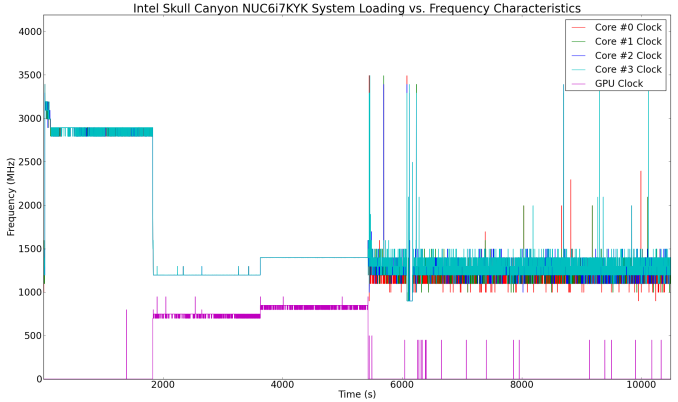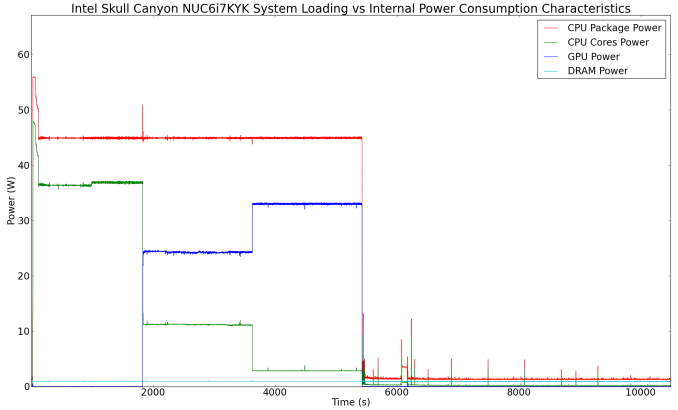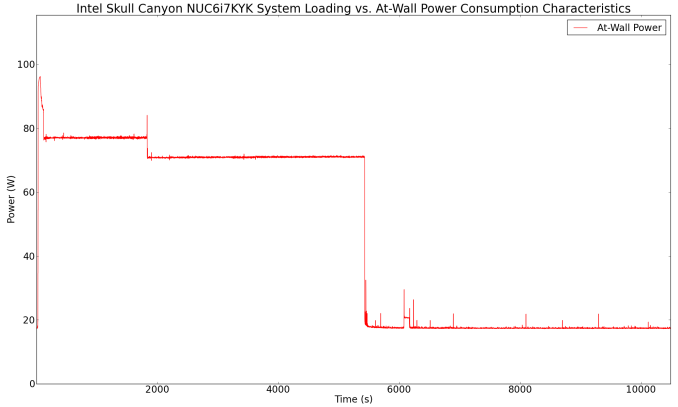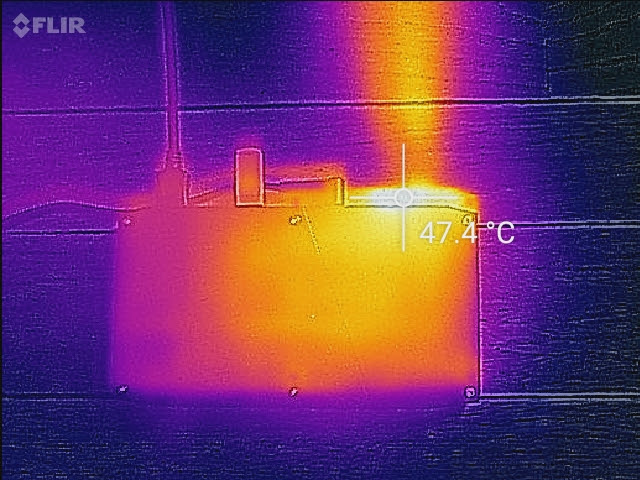The Intel Skull Canyon NUC6i7KYK mini-PC Review
by Ganesh T S on May 23, 2016 8:00 AM ESTPower Consumption and Thermal Performance
The power consumption at the wall was measured with a 1080p display being driven through the HDMI port. In the graphs below, we compare the idle and load power of the Intel NUC6i7KYK (Skull Canyon) with other low power PCs evaluated before. For load power consumption, we ran Furmark 1.12.0 and Prime95 v27.9 together. The idle number is a bit disappointing, though, I assume that a change in the BIOS to the low power profile could help improve things. Otherwise, the idle number is just slightly higher than what is typical for a system with a 45W TDP CPU and a PCIe M.2 SSD.


The load power number in the graph above is the maximum sustained value. As we can see from the graphs below, instantaneous peak numbers can go as high as 95W. Addition of bus-powered USB devices will also tend to drive up this number further.
Our thermal stress routine starts with the system at idle, followed by 30 minutes of pure CPU loading. This is followed by another 30 minutes of both CPU and GPU being loaded simultaneously. After this, the CPU load gets removed, allowing the GPU to be loaded alone for another 30 minutes. The various clocks in the system as well as the temperatures within the unit are presented below.
The graph below present the power consumption profile of various blocks in the CPU package during the course of our thermal stress. Following that, we have the power consumption at the wall for the system during the same period.
According to the official specifications, the junction temperature of the Core i7-6770HQ is 100 C. Unfortunately, the cooling solution is not able to prevent the CPU from hitting it with turbo speeds activated. However, the frequency does remain above the base 2.6 GHz throughout the pure CPU loading segment. The package power settles down to a steady 45W, and that continues throughout the duration of our test. Our only concern is that the cooling solution keeps the temperature of the cores too close to the junction temperature during periods of heavy CPU load. Once the load gets distributed across both the CPU and the GPU, we see the package come down to around 90C.
Another important aspect to keep note of while evaluating mini-PCs is the chassis temperature. Using the Android version of the FLIR One thermal imager, we observed the chassis temperature after the CPU package temperature reached the steady state value in the above graph.
We have additional thermal images in the gallery below.
The maximum chassis temperature observed by the thermal imager was slightly above 60 C near the fan's exhaust vent. At that point, a sound level Android app running on the HTC One M7 recorded 59 dB. For comparison purposes, the Zotac ZBOX MAGNUS EN970 recorded 50 dB in a similar scenario.







_thumb.jpg)

_thumb.jpg)

_thumb.jpg)









133 Comments
View All Comments
utferris - Monday, May 23, 2016 - link
This can be better with ECC memory support. I just can not use any machine without ECC for work.ShieTar - Monday, May 23, 2016 - link
But a low-frequency consumer quad-core is fine? What exactly do you do at work?Gigaplex - Tuesday, May 24, 2016 - link
Sometimes reliability is more important than performance.close - Monday, May 23, 2016 - link
Guess ECC is not high on the list for potential NUC buyers, even if it's a Skull Canyon NUC. I think most people would rather go for better graphics than ECC.kgardas - Monday, May 23, 2016 - link
Indeed, the picture shows SO-DIMM ECC, but I highly doubt this is even supported since otherwise it's not Xeon nor Cxxx chipset...close - Tuesday, May 24, 2016 - link
http://ark.intel.com/search/advanced?ECCMemory=tru...tipoo - Monday, May 23, 2016 - link
What work do you want to do on a 45W mobile quad with (albeit high end) integrated graphics, that needs ECC?I wonder how that would work with the eDRAM anyways, the main memory being ECC, but not the eDRAM.
Samus - Monday, May 23, 2016 - link
All of the cache in Intel CPU's is ECC anyway. Chances of errors not being corrected by bad information pulled from system RAM is rare (16e^64) in consumer applications.ECC was more important when there was a small amount of system RAM, but these days with the amount of RAM available, ECC is not only less effective but less necessary.
I'm all for ECC memory in the server/mainframe space but for this application it is certainly an odd request. This is, for the most part, a laptop without a screen.
TeXWiller - Tuesday, May 24, 2016 - link
>ECC was more important when there was a small amount of system RAM,The larger the array the larger target it is for the radiation to hit. Laptops are often being used in high altitude environments with generally less shielding than the typical desktop or even a server so from that perspective ECC would seem beneficial basic feature. Then there are the supercomputers, a fun read: http://spectrum.ieee.org/computing/hardware/how-to...
BurntMyBacon - Tuesday, May 24, 2016 - link
@TeXWiller: "The larger the array the larger target it is for the radiation to hit."While this is true, transistor density has improved to the point that, despite having magnitudes more capacity, the physical array size is actually smaller. Of course the transistors are also more susceptible given the radiant energy is, relatively speaking, much greater compared to the energy in the transistor than it was when transistors were larger. There is also the consideration that as transistor density increases, it becomes less likely that radiation will strike the silicon (or other substrate), but miss the transistor. So we've marginally decreased the chance that radiation will hit the substrate, but significantly increased the change that any hit that does occur will be meaningful.